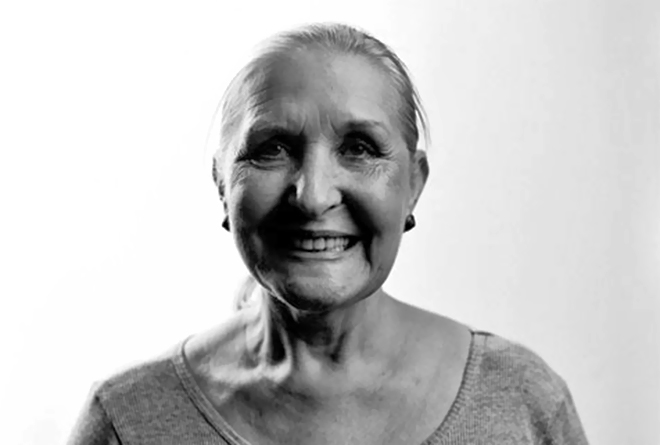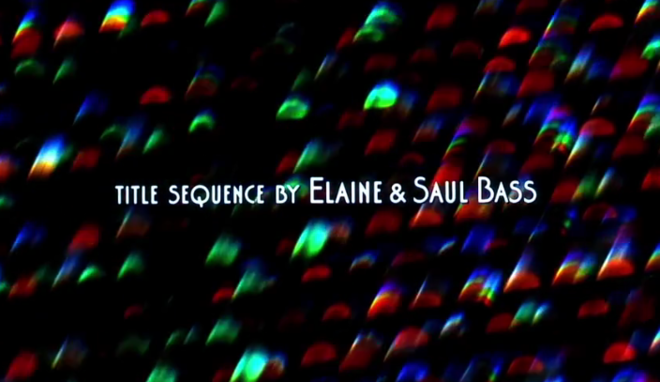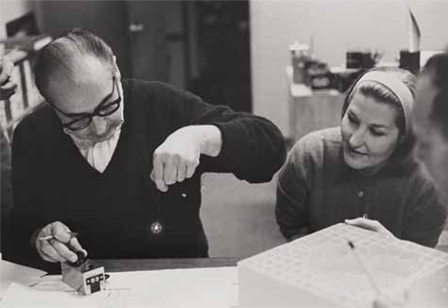Designer
Elaine Bass

Elaine Bass (née Makatura) is an American title designer and filmmaker. She was the partner and close collaborator of designer and filmmaker Saul Bass for more than 40 years.
In the 1960s, Elaine contributed to the title sequences for Spartacus (1960), West Side Story (1961), Something Wild (1962), Walk on the Wild Side (1962), Nine Hours to Rama (1963), The Victors (1963), Seconds (1966), and Grand Prix (1966), and in the ’80s and ’90s to Broadcast News (1987), Tonkô (1988), Big (1988), The War of the Roses (1989), Goodfellas (1990), Doc Hollywood (1991), Cape Fear (1991), Mr. Saturday Night (1992), The Age of Innocence (1993), Higher Learning (1995), and Casino (1995).

Credits for Elaine & Saul Bass in the Casino (1995) main titles
Born to Hungarian immigrants in New York in 1927, Elaine’s early years were full of drawing and singing. From age twelve to eighteen, she and her sisters sang professionally as the Belmont Sisters. Thereafter, Elaine worked in the ready-to-wear fashion industry in New York until leaving for Los Angeles in 1947, where she got a job in the design department at Capitol Records.

Saul and Elaine Bass work out a special effect, 1967
In 1955 Elaine got a job as the assistant to graphic and title designer Saul Bass. In 1960 Elaine directed on her own for the first time with the opening title sequence to Spartacus. Much of Saul Bass’s title design and film work thereafter was made in close collaboration with Elaine. The following year, Saul and Elaine married. In the ’60s, they collaborated on the title sequences to West Side Story (1961), Walk on the Wild Side (1962), Nine Hours to Rama (1963), The Victors (1963), Seconds (1966), and Grand Prix (1966).
After the birth of their children, Jennifer in 1964 and Jeffrey in 1967, the Basses stepped away from titles to concentrate on their family and short films. Their first joint venture into short filmmaking was with promotional films for two pavilions at the 1964 World’s Fair, From Here to There for United Airlines and The Searching Eye for Eastman Kodak. In 1968, they made the short film Why Man Creates, which won an Oscar.
Why Man Creates (1968), the Oscar-winning short film directed by Saul and Elaine Bass
About this period, Saul has said,
“Elaine and I feel we are there to serve the film and to approach the task with a sense of responsibility. We saw a lot of pyrotechnics and fun and games and I suppose we lost interest. At the same time, an increasing number of directors now sought to open their own films in ambitious ways rather than hire someone else to do it. Whatever the reasons, the result was ‘Fade Out.’ We did not worry about it: we had too many other interesting projects to get on with. Equally, because we still loved the process of making titles, we were happy to take it up again when asked. ‘Fade In’…"
Bass was “rediscovered” by James L. Brooks and Martin Scorsese in the late ’80s, who urged the Basses to return to main title design. They created the title sequences for films Broadcast News, Big, Mr. Saturday Night, The War of the Roses, Higher Learning, and for Scorsese, Goodfellas, Cape Fear, The Age of Innocence, and Casino, their last title sequence together.
After the death of Saul Bass in 1996, Elaine collaborated with title designer Pablo Ferro to update the opening for the remake of Psycho (1998).
In a sense, all modern opening title sequences that introduce the mood or theme of a film are a legacy of the Basses’ work.
Articles
-

The Title Design of Saul and Elaine Bass
feature
-

Psycho
interview
-

Casino
summary
-

Higher Learning
title only
-

The Age of Innocence
summary
-

Mr. Saturday Night
title only
-

Cape Fear
summary
-

Goodfellas
summary
-

The War of the Roses
summary
-

Tonkô
summary
-

Big
title only
-

Broadcast News
summary
-

Grand Prix
summary
-

Seconds
summary
-

The Victors
summary
-

Nine Hours to Rama
summary
-

Walk on the Wild Side
summary
-

Something Wild
summary
-

West Side Story
summary
-

Spartacus
summary
